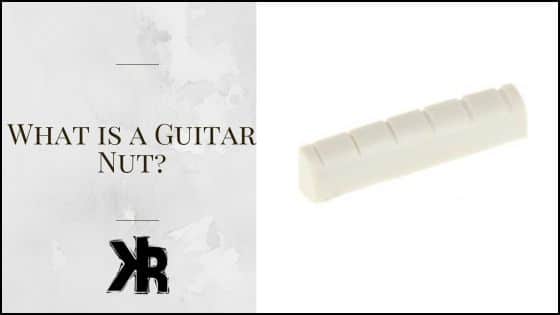Table of Contents
When it comes to the anatomy of a guitar, some parts like the body, neck, and pickups often steal the spotlight. However, one small but crucial component that often goes unnoticed is the guitar nut. So, what is a guitar nut?
A guitar nut is a small piece of hard material that supports the strings at the end closest to the headstock or scroll.
It’s a crucial component of a guitar that keeps the strings in line on their way to the tuners. It also helps to keep the strings in place so that they won’t slide out of tune or off the guitar when you bend a note.
In this Killer Rig article, we’ll explore the ins and outs of the guitar nut, its function, and why it’s more important than you might think.
What Is A Guitar Nut?
A guitar nut is a small, rectangular piece typically made of bone, plastic, brass, or graphite. It’s located at the top end of the guitar neck, right where the headstock begins.
The nut serves as a guide for the strings, helping to space them evenly across the fretboard and elevate them above the fingerboard at an optimal height.
In essence, the nut acts as the zero fret, providing a clear starting point for the scale length of each string.
Its design and material can significantly influence the guitar’s tone, sustain, and overall playability. It also contributes to how much sustain is produced by the guitar.
In the image below, you can see exactly what the nut should looks like:
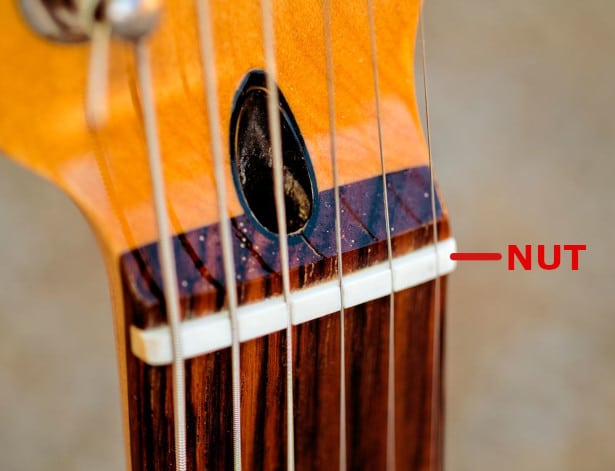
Types of Guitar Nut Material
Guitar nuts come in a variety of materials, each with its own set of benefits and drawbacks. The most common materials used to make guitar nuts are found below.
Plastic
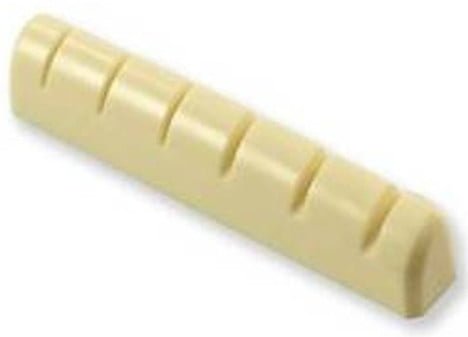
Plastic is the most affordable option and is therefore popular among beginner guitarists. However, plastic tends to wear out quickly and doesn’t hold up well under heavy use. This material also doesn’t resonate as well as some of the others, resulting in less sustain.
You will find plastic nuts are also very common with cheaper guitars that are made in countries overseas.
In order to keep prices down, they use parts that are not as high in quality as others. This doesn’t mean they are a poor choice, but it does depend on how hard the plastic is.
Bone
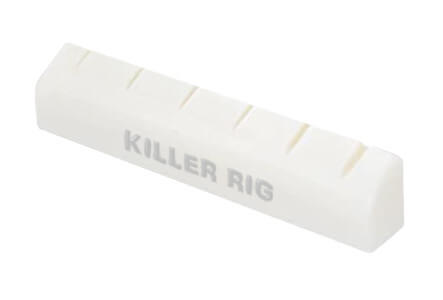
Bone is a more durable option than plastic and produces better resonance and tuning stability. However, bone is more expensive than plastic, and so they are not usually put onto guitars at the factory. Only those with a higher price point might come with a bone nut.
Bone nuts are considered to be some of the best and are highly sought after by guitar players who know of their benefit.
They are quite noticeable when changing from a material like plastic. Both sound and performance will improve. In case you were curious, the bone comes from cows.
Graphite
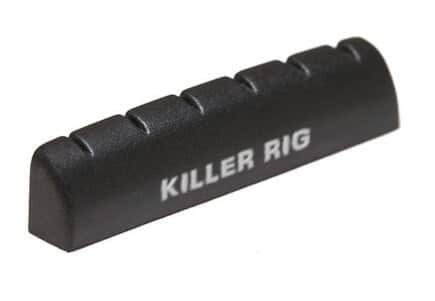
Graphite is another option that is somewhere between bone and plastic in terms of quality. Graphite is a little bit more affordable than bone, but doesn’t last as long. However, it does offer slightly better resonance than plastic.
This material is self-lubricating and so there is no binding between the strings and the graphite nut.
This can be a great way to resolve any tuning issues you might have because of binding in the nut. It also makes any bending and tremolo work more stable, as the strings will remain in tune afterward.
Metal
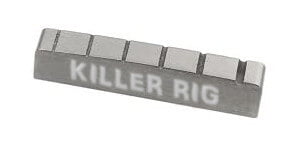
Metal, in all its strength and resilience, can produce remarkable vibrations and dependable fine-tuning for guitars, not to mention a lasting sustain.
Yet, it’s no secret that it comes with a hefty price tag. For that reason, despite its high quality, it’s a rarity to see this choice even on premium guitars. Varieties of this robust material include brass, titanium, steel, aluminum, and a handful more.
Should your guitar possess a metal nut, you’ll discover that it keeps pitch with unrivaled consistency. Still, this doesn’t come without a hiccup or two. Adjusting and modifying these can pose a bit of a challenge.
As for the tone, it can be strikingly vivid, outshining other materials in brightness. Hence, for genres like bluegrass that love to bask in the spotlight, metal nuts can be the go-to.
Tusq
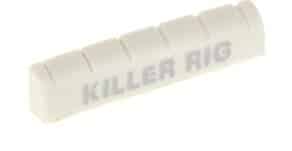
Tusq is a synthetic material made by Graph Tech. It is designed to offer the benefits of bone and graphite, without the drawbacks.
This material is quite affordable and offers great resonance and sustain. It’s also self-lubricating, which means there are no tuning issues.
This material has become increasingly popular in recent years as more guitar companies have started using it. You will find Tusq nuts on guitars from Fender, Gibson, PRS, Ibanez, and more.
Tusq is also so close to bone in terms of sound that guitars within many price points are made using it.
Ebony

Ebony is another material that has been used as guitar nuts for centuries. However, newer ebony materials are much softer than what was used in the past. This material can still be used as guitar nuts, but the sound is a bit darker and the sustain is less than bone.
Ebony nuts can be a great choice when used with mahogany guitars that are already dark. If you prefer a more dark-sounding guitar, then this is a good nut material choice.
Ivory
Ivory is a beautiful material that has been used on guitars for centuries. It’s also quite rare and now illegal to harvest in many countries. As such, it’s become quite expensive and is not something we recommend.
If you can find a fossilized ivory nut for your guitar, you will be rewarded with great resonance and sustain. This material is also quite hard and can be tricky to work with.
There are better alternatives today, so there is no need to go to such lengths to obtain this material.
Guitar Nut Designs
When you’re eyeing that guitar, it’s not just the material of the nut that matters. The design plays a pivotal role in how your guitar performs. Let’s break down the most common designs you’ll encounter:
Standard
This is your run-of-the-mill, most frequently seen design. It’s usually rectangular and flat-bottomed, featuring slots that guide each string to the tuners. Simple, but effective.
Locking
If you’re into dive bombs or heavy tremolo use, this one’s for you. Locking nuts clamp down on your strings right behind the nut, keeping everything in tune even under heavy whammy bar abuse.
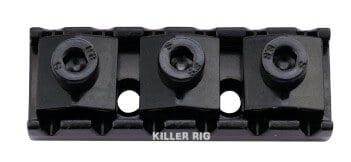
Zero Fret
This design places a ‘zero fret’ right in front of the nut. The advantage is improved intonation and string action. This is because the string height is determined by the zero fret rather than the nut slots.
Adjustable Nut
For the tinkerers out there, an adjustable nut lets you raise or lower the string action right at the nut, giving you another layer of customization for your setup.
Roller Nut
For those who frequently use a tremolo system or simply want to reduce string friction, the roller nut is a game-changer.
It features small rollers for each string, allowing for smoother string movement and better tuning stability. This design is particularly useful for guitarists who employ a lot of bends or aggressive playing techniques.
Importance in Playability and Tone
The guitar nut may be small, but its impact on playability and tone is anything but minor. Here’s how it makes a difference:
Playability
- String Spacing: The nut ensures that the strings are evenly spaced across the fretboard, which affects how comfortable the guitar is to play.
- Action: The height of the nut slots determines the action of the strings at the first few frets. A well-cut nut allows for smooth fretting and bending without any buzzing.
- Intonation: While often overlooked, the nut plays a part in your guitar’s intonation. If the slots are cut at the correct depth and width, the strings will have the proper tension, contributing to accurate intonation.
Tone
- Sustain: The material of the nut can affect how long the strings vibrate, impacting the sustain of the guitar.
- Tonal Quality: Different materials produce different tonal characteristics. For example, bone nuts are often praised for their ability to produce a warm, rich tone. While metal nuts can offer a brighter sound.
- Harmonics and Overtones: The nut can also influence the harmonic content of your sound. A well-crafted nut can help bring out the natural harmonics and overtones in the strings, adding complexity to your tone.
Conclusion
There is a lot to consider when it comes to guitar nuts. You need to think about the material, the design, and the size.
But once you have all of that sorted out, you will be rewarded with better resonance, sustain, and tuning stability. So don’t overlook this important piece of hardware on your guitar.
FAQs
What’s The Best Guitar Nut Material?
The material of the guitar nut can make a difference in the sound and performance of the instrument. Harder materials like bone will give you better sustain, while anything softer like Graph Tech Tusq will give you more resonance.
Moving from plastic to graphite nuts can make a big difference in tuning stability and prevent binding. So if you want to make a noticeable difference for cheap, a new nut can be a good upgrade.
So the best material will be one that is hard and offers some lubrication, like bone or tusq.
How long do guitar nuts last?
A guitar nut that is made of a quality material, should last many years. This is assuming that it doesn’t take any damage and is treated delicately.
Lower quality nuts will wear faster and should be replaced once the groves are too wide. You can normally tell this when your action or tuning become affected.
When should you replace a guitar nut?
If the guitar nut is damaged, then it will need to be replaced without question. But even if it’s not damaged, you might want to replace it if you are not happy with the sound or performance of the guitar.
A new nut can make a big difference in sustain, resonance, tuning stability, and even sound.

